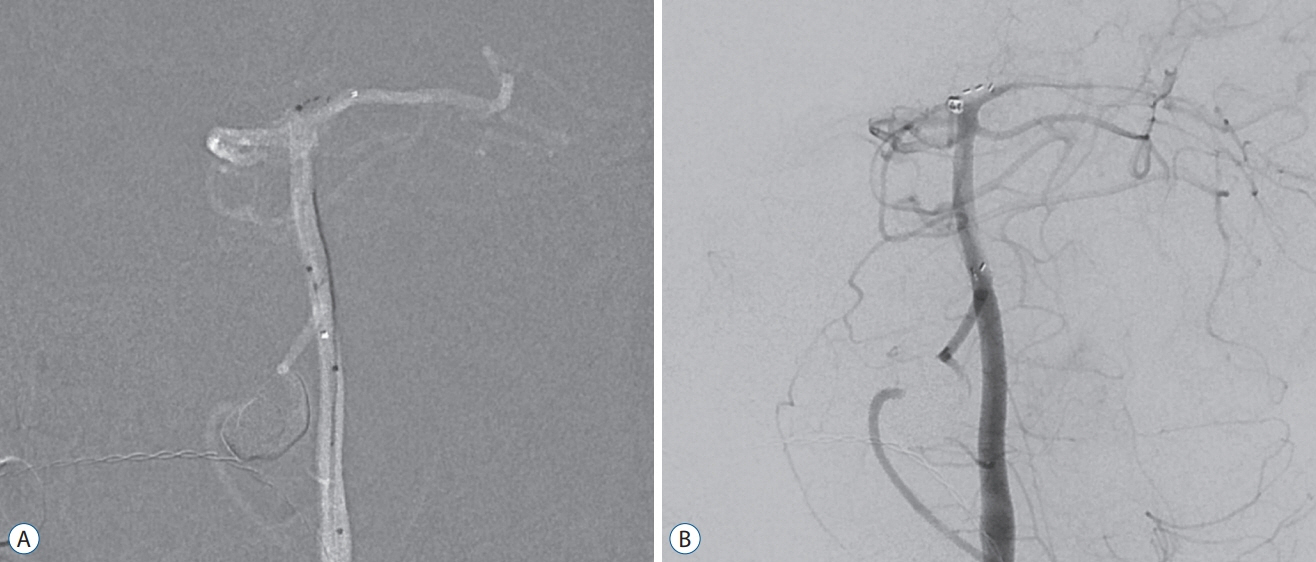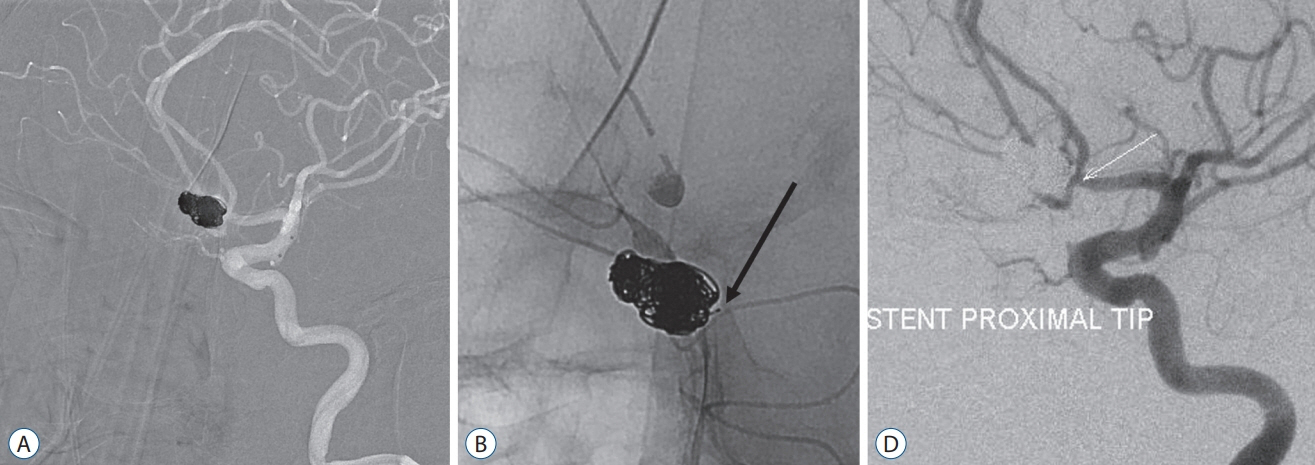J Korean Neurosurg Soc.
2020 Jan;63(1):80-88. 10.3340/jkns.2019.0154.
Clinical Safety and Effectiveness of Stent-Assisted Coil Embolization with Neuroform Atlas Stent in Intracranial Aneurysm
- Affiliations
-
- 1Department of Neurosurgery, Pusan National University Yangsan Hospital, Pusan National University School of Medicine, Yangsan, Korea
- KMID: 2501695
- DOI: http://doi.org/10.3340/jkns.2019.0154
Abstract
Objective
: Stent-assisted coil embolization (SAC) is commonly used for treating wide-neck intracranial aneurysms. In this study, we aimed to assess the clinical safety and efficacy of the NeuroForm Atlas Stent during SAC of intracranial aneurysms.
Methods
: We retrospectively analyzed data from patients with ruptured and unruptured cerebral aneurysms, who underwent SAC using the NeuroForm Atlas between February 2018 and July 2018. Favorable clinical outcomes and degree of aneurysm occlusion were defined as a modified Rankin scale score of ≤2 and a Raymond-Roy occlusion classification (RROC) class I/II during the immediate postoperative period and at the 6-month follow-up, respectively.
Results
: Thirty-one consecutive patients with 33 cases, including 11 ruptured and 22 unruptured cases were treated via NeuroForm Atlas SAC. Among the 22 unruptured cases with 24 unruptured aneurysms had favorable clinical outcome. Complete occlusion (RROC I) was achieved in 16 aneurysms (66.7%), while neck remnants (RROC II) were observed in six aneurysms (25%). Among the 11 patients with ruptured aneurysms, two died due to re-bleeding and diabetic ketoacidosis. In ruptured cases, RROC I was observed in eight (72.7%) and RROC II was observed in three cases (27.3%). At the 6-month follow-up, no clinical events were observed in the 22 unruptured cases. In the ruptured nine cases, five patients recovered without neurologic deficits, while four experienced unfavorable outcomes at 6 months. Of the 29 aneurysms examined via angiography at the 6-month follow-up, 19 (65.5%) were RROC I, eight (27.6%) were RROC II and two (6.9%) were RROC III. There were no procedure-related hemorrhagic complications.
Conclusion
: In this study, we found that stent-assisted coil embolization with NeuroForm Atlas stent may be safe and effective in the treatment of wide-neck intracranial aneurysms. NeuroForm Atlas SAC is feasible for the treatment of both ruptured and unruptured wide-neck aneurysms.
Keyword
Figure
Cited by 1 articles
-
Outcomes of Stent-Assisted Coiling Using the Neuroform Atlas Stent in Unruptured Wide-Necked Intracranial Aneurysms
Ohyuk Kwon, Joonho Chung
J Korean Neurosurg Soc. 2021;64(1):23-29. doi: 10.3340/jkns.2020.0054.
Reference
-
References
1. Aydin K, Arat A, Sencer S, Barburoglu M, Men S. Stent-assisted coiling of wide-neck intracranial aneurysms using low-profile LEO baby stents: initial and midterm results. AJNR Am J Neuroradiol. 36:1934–1941. 2015.
Article2. Behme D, Weber A, Kowoll A, Berlis A, Burke TH, Weber W. Lowprofile visualized intraluminal support device (LVIS Jr) as a novel tool in the treatment of wide-necked intracranial aneurysms: Initial experience in 32 cases. J Neurointerv Surg. 7:281–285. 2015.
Article3. Brilstra EH, Rinkel GJ, van der Graaf Y, van Rooij WJ, Algra A. Treatment of intracranial aneurysms by embolization with coils: a systematic review. Stroke. 30:470–476. 1999.
Article4. Cho WS, Kim JE, Park SQ, Ko JK, Kim DW, Park JC, et al. Korean clinical practice guidelines for aneurysmal subarachnoid hemorrhage. J Korean Neurosurg Soc. 61:127–166. 2018.
Article5. Ge H, Lv X, Yang X, He H, Jin H, Li Y. Lvis stent versus enterprise stent for the treatment of unruptured intracranial aneurysms. World Neurosurg. 91:365–370. 2016.
Article6. Jankowitz BT, Hanel R, Jadhav AP, Loy DN, Frei D, Siddiqui AH, et al. Neuroform Atlas stent system for the treatment of intracranial aneurysm: primary results of the atlas humanitarian device exemption cohort. J Neurointerv Surg. 11:801–806. 2019.
Article7. King B, Vaziri S, Singla A, Fargen KM, Mocco J. Clinical and angiographic outcomes after stent-assisted coiling of cerebral aneurysms with enterprise and neuroform stents: a comparative analysis of the literature. J Neurointerv Surg. 7:905–909. 2015.
Article8. Molyneux AJ, Birks J, Clarke A, Sneade M, Kerr RS. The durability of endovascular coiling versus neurosurgical clipping of ruptured cerebral aneurysms: 18 year follow-up of the UK cohort of the international subarachnoid aneurysm trial (ISAT). Lancet. 385:691–697. 2015.
Article9. Poncyljusz W, Bilinski P, Safranow K, Baron J, Zbroszczyk M, Jaworski M, et al. The LVIS/LVIS Jr. stents in the treatment of wide-neck intracranial aneurysms: multicentre registry. J Neurointerv Surg. 7:524–529. 2015.
Article10. Ten Brinck MFM, de Vries J, Bartels RHMA, Grotenhuis JA, Boogaarts HD. NeuroForm Atlas stent-assisted coiling: preliminary results. Neurosurgery. 84:179–189. 2019.
Article11. Ulfert C, Pham M, Sonnberger M, Amaya F, Trenkler J, Bendszus M, et al. The Neuroform Atlas stent to assist coil embolization of intracranial aneurysms: a multicentre experience. J Neurointerv Surg. 10:1192–1196. 2018.
Article12. Wang F, Chen X, Wang Y, Bai P, Wang HZ, Sun T, et al. Stent-assisted coiling and balloon-assisted coiling in the management of intracranial aneurysms: a systematic review & meta-analysis. J Neurol Sci. 364:160–166. 2016.
Article13. Yoon CH, Lee HW, Kim YS, Lee SW, Yeom JA, Roh J, et al. Preliminary study of tirofiban infusion in coil embolization of ruptured intracranial aneurysms. Neurosurgery. 82:76–84. 2018.
Article
- Full Text Links
- Actions
-
Cited
- CITED
-
- Close
- Share
- Similar articles
-
- Safety and effectiveness of Neuroform Atlas stent-assisted coil embolization for ruptured intracranial aneurysms
- Delayed Self-expansion Phenomenon as a Complication of Neuroform Stent Assisted Coiling for Ruptured Intracranial Aneurysm
- In-Stent Stenosis of Stent-Assisted Coil Embolization of the Supraclinoid Internal Carotid Artery Aneurysm
- Emergent Endovascular Treatment of Ruptured Dissecting Aneurysm of the Intradural Vertebral Artery Using a Self-Expandable Intracranial Stent and a Bioactive Hydrophilic coil
- Initial Experience with Neuroform EZ in the Treatment of Wide-neck Cerebral Aneurysms





